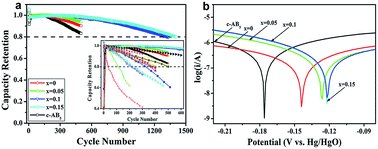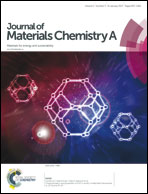A start of the renaissance for nickel metal hydride batteries: a hydrogen storage alloy series with an ultra-long cycle life†
Abstract
Nickel metal hydride (Ni-MH) batteries have demonstrated key technology advantages for applications in new-energy vehicles, while the main challenge derives from the insufficient cycle lives (about 500 cycles) of their negative electrode materials—hydrogen storage alloys. As a result, progress in their development has been very limited over the past decades. Here we propose a theoretical framework to design a series of long-life and low-cost hydrogen storage alloys, by considering the electronegativities of the elements to enhance the alloys' corrosion resistance. Two novel candidate alloys, La0.6Ce0.3Y0.1Ni3.7Co0.75Mn0.3Al0.35 and La0.55Ce0.3Y0.15Ni3.7Co0.75Mn0.3Al0.35, show ultra-long cycle lives of 1325 and 1407 cycles, respectively, which are almost triple that of the commercial alloy (MmNi3.55Co0.75Mn0.4Al0.3) that is used in Ni-MH batteries. The usage costs of Ni-MH batteries based on these two alloys are only 1/4 of that of the lithium-ion battery, showing better market prospects for large-scale applications.



 Please wait while we load your content...
Please wait while we load your content...